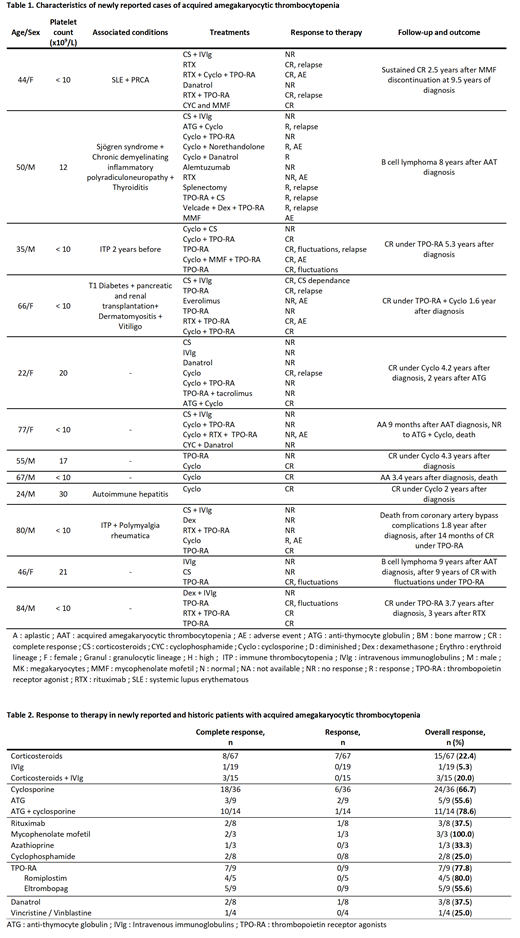Abstract
Introduction
Acquired amegakaryocytic thrombocytopenia (AAT) is an extremely rare disease characterized by acquired megakaryocytic aplasia or hypoplasia with no other lineage abnormalities. Given limited evidence, the first aim of this study was to describe the characteristics, management and outcome of patients with AAT, the second aim was to examine the therapeutic response through a systematic review of published case reports.
Patients and Methods
We carried out a retrospective multicenter study through the French Reference Network for Adult Autoimmune Cytopenias, including patients aged > 18 years with acquired thrombocytopenia with a platelet count < 50 x 10 9/L, associated with a megakaryocytes / granulocytes ratio < 50 % on bone marrow, diagnosed from July 2007 to February 2020. Exclusion criteria were: abnormal granular lineage, evidence of dysplasia, bone marrow infiltration by tumor cells or hematologic malignancy, significant karyotype abnormality, and significant paroxysmal nocturnal hemoglobinuria clone. Bone marrow biopsy were centrally reviewed. Patients' medical charts were collected using the standardized form of the referral center for adult immune thrombocytopenia (ITP). Response to treatment was defined according to standardized international criteria for ITP: response (R) and complete response (CR) were respectively defined as platelet count of > 30 × 10 9/L with at least a doubling of the baseline value, and platelet count of > 100 × 10 9/L ; overall response as either R or CR. We performed a systematic review conducted through Medline and Scopus databases from 1970 to April 2021. Cases were included in the analysis if initial platelet count was < 50 x 10 9/L and bone marrow examination was available, demonstrating a megakaryocyte hypoplasia or aplasia with no alternate diagnosis.
Results
We screened 23 patients reported as thrombocytopenia with absence or decreased megakaryocytes. Eleven patients were excluded because of: presence of megakaryocytes on bone marrow biopsy despite megakaryocytic aplasia on bone marrow aspirate (n=2), absence of bone marrow biopsy (n=4), aplastic or hypoplastic bone marrow (n=3), moderate thrombocytopenia > 50 x 10 9/L (n=1), lack of data (n=1). Twelve patients were included in the analysis. AAT patients had a median age of 52.5 years, 5/12 (41.7%) were female, 6/12 (50%) had a preexisting autoimmune disease (Table 1). All bone marrow biopsies reviewed to date contained CD8+ T-cell infiltrates. Eight patients received a first line treatment with corticosteroids and/or intravenous immunoglobulins (IVIg), a single response was observed. Ten patients received cyclosporine in monotherapy resulting in 4CR, and 1R or in combination with diverse agents with heterogenous responses. Six had received a single therapy with thrombopoietin receptor agonists (TPO-RAs) inducing 4 CR. Eventually, 9 patients (75%) achieved a CR under therapy, obtained with ciclosporin alone in 3 cases, ciclosporin in association with TPO-RA or ATG in 2 cases, cyclophosphamide followed-up by mycophenolate mofetil in 1 case, and TPO-RAs alone in 4 patients (of whom 3 had previously received at least on immunosuppressive therapy). After a median follow up time of 4.0 years (range 1.2 - 11.9), 2 (16%) patients eventually developed an aplastic anemia, 7 and 41.5 months respectively after initial AAT diagnosis. The literature search yielded 108 articles, of which 75 articles reporting 85 cases were included in the final analysis. The pooled analysis of newly reported and historic cases included 97 cases. Overall response rates to corticosteroids and IVIg were respectively 22.4 % and 5.3 % (Table 2). Ciclosporin was used as single agent in 37.1 % of patients, with an overall response rate of 66.7 %. TPO-RAs were used in 9 cases, with a CR in 7 patients (77.8%). Overall, 9/97 patients (9.3 %) experienced an aplastic anemia during the follow-up. The presence of a thymoma was associated with a higher risk of aplastic anemia (OR 6.83 (95%CI 1.22-34.00, p=0.020)).
Conclusion
Distinguishing AAT from ITP is of significance as the outcome and response to therapy strongly differ. Aplastic anemia may occur in the follow-up but remain rare. Corticosteroids and IVIg are inefficient in most cases, ciclosporin appear to be very effective, TPO-RA could also be an option, as single therapy or in associations. Further data will be needed to define the respective place of these treatments.
Moulis: Amgen: Membership on an entity's Board of Directors or advisory committees, Research Funding; Argenix: Membership on an entity's Board of Directors or advisory committees; Grifols: Membership on an entity's Board of Directors or advisory committees, Research Funding; Novartis: Membership on an entity's Board of Directors or advisory committees, Research Funding; Sobi: Membership on an entity's Board of Directors or advisory committees. Ebbo: Grifols: Honoraria, Membership on an entity's Board of Directors or advisory committees; Octapharma: Other: Attendance Grant; Amgen: Honoraria; Sobi: Other: Attendance Grant; Novartis: Honoraria, Membership on an entity's Board of Directors or advisory committees. Terriou: Sanofi: Honoraria, Membership on an entity's Board of Directors or advisory committees, Research Funding. Haioun: Amgen: Honoraria, Research Funding; Celgene: Honoraria, Research Funding; Gilead: Honoraria, Research Funding; Janssen: Honoraria, Research Funding; Novartis: Honoraria, Research Funding; F. Hoffmann-La Roche Ltd: Honoraria, Research Funding; Servier: Honoraria, Research Funding; Takeda: Honoraria, Research Funding; Miltenyi: Honoraria, Research Funding. Michel: Amgen,Novartis,UCB,Argenx,Rigel: Honoraria. Godeau: Amgen: Consultancy; Novartis: Consultancy; Grifols: Consultancy; Sobi: Consultancy. Mahevas: GSK: Research Funding; Amgen: Honoraria.


This feature is available to Subscribers Only
Sign In or Create an Account Close Modal